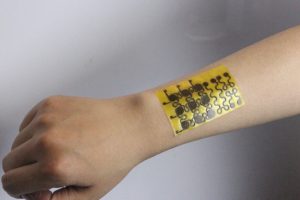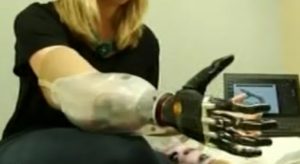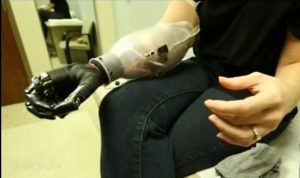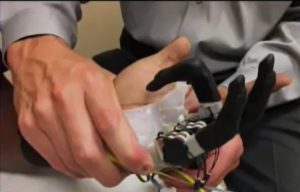Scientists and engineers are making rapid progress in the development of artificial manipulative limbs that are both as dexterous and sensitive as human arms and hands. A significant step in that direction has been taken by researchers at the University of Colorado in Boulder who have created a new form of electronic or e-skin.
The new material is composed of a type of polymer known as a polyimine to which silver nanoparticles have been added to give it strength, stability and electrical conductivity. The e-skin can be formed into thin, translucent sheets that can be wrapped around artificial limbs. The material can also have sensors embedded within it given the e-skin the ability to sense pressure, temperature and even humidity, making the artificial limb more like a real human one. The image below shows a sample of e-skin on a real human arm for comparison.

The ability to sense pressure in particular has long been a goal of researchers. Think of how difficult it would be to pick up an egg or a glass of water if you couldn’t tell whether or not you were squeezing it too hard.
This new technology will give both human prosthetics and robots the ability to feel as if they had human skin. According to Chemistry Professor Wei Zhang of CU Boulder and co-author of the study; “If you think about what real skin can do, real skin can prevent people getting burned…can prevent people getting hurt.”
Program leader Jianliang Xiao, Professor of Mechanical Engineering describes the benefits of e-skin in robotics. “Sensing is important because when human beings interact with robots we want to make sure that robots don’t hurt people.”
E-skin has several other amazing properties as well. For one the material can repair itself simply by mixing the compounds from which it is formed in ethanol and applying the mixture to the damaged area. Finally, e-skin can even be recycled by immersing it in a solution that breaks it down into its component chemicals that can then be reused to produce new e-skin. Even the silver nanoparticles can be recovered as they sink to the bottom; nothing is wasted or thrown away.
Other scientists are also working on other versions of e-skin so one thing is certain, prosthetics like Luke Skywalker’s arm and androids like Data are only a matter of time.
At the same time scientists are also busy working on improving the interface between the human nervous system and artificial limbs with the goal of increasing the dexterity of prosthetic devices. Considerable progress is being made at the OrthoCarolina Reconstructive Center for Lost Limbs by hand surgeons Glenn Gaston M. D. and Bryan Loeffler M. D.
What Doctors Gaston and Loeffler have developed is a surgical technique to transfer nerves that once controlled the lost hand of amputees to other parts of the arm, reinserting those nerve endings into another muscle. The signals that would have been sent from the brain to the hand through these nerves can then be picked up by transducers implanted in the same muscle as the nerves and used to control a prosthetic hand. In other words the patient controls their new, artificial hand just as they had their natural hand. See images below.


Doctors Gaston and Loeffler call their procedure ‘Targeted muscle reinnervation surgery’ and so far they have had amazing success giving their patients artificial arms and hands with the ability of control the wrist, thumb and fingers as a group. In one recent operation however a man who had lost his middle, fourth and little fingers was given a prosthetic that for the first time the ability to control each artificial finger separately, a major advance. See image below.

Combining the progress of the University of Colorado at Boulder with that at OrthoCarolina brings the long-term goal of prosthetic limbs that truly are every bit as ‘human’ as our natural ones several steps closer to reality.
